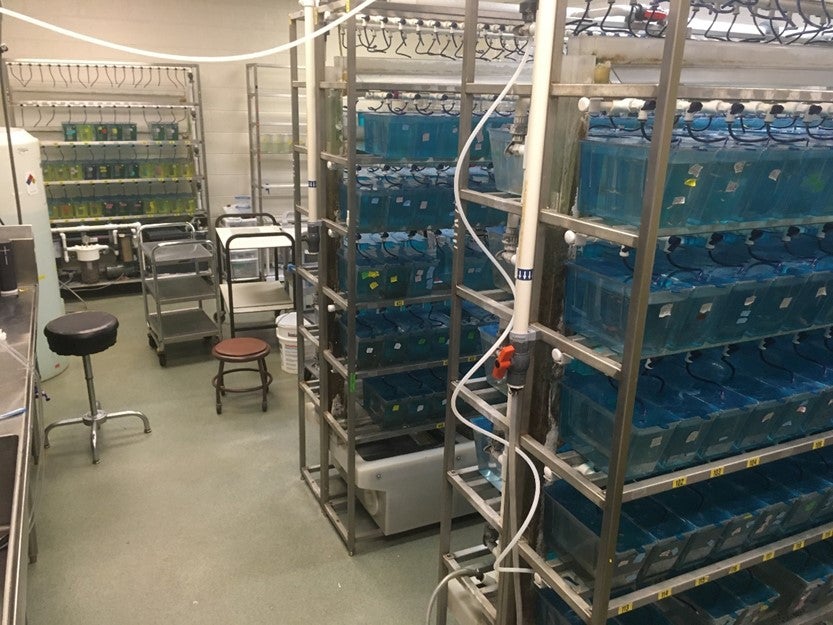Animal Models Shared Resource – Zebrafish
Instrumentation and Services

Services offered by the AMSR-Zebrafish include:
- Provide patient biopsy xenografts in zebrafish embryos (Zevatars) as clinical diagnostic tools to inform personalized cancer care.
- Perform zebrafish xenograft models to investigate cancer biology, and for anti-cancer drug screening.
- Consult on all aspects of zebrafish research; provide advice and guidance on the use and applications of methodologies and on experimental design; conduct experiments
- Design custom experimental protocols to fit specific requirements for the research needs of individual investigators
- Assist with the writing of properly powered grant proposals and scientific manuscripts
- Train at all levels and on all aspects of zebrafish research
- Mentor technicians and students involved in projects
Research services:
- Maintain a breeding colony of zebrafish including several wild-type strains, in addition to several mutant and transgenic lines that are highly useful for cancer-related and other research
- Provide consultation on potential uses of the zebrafish model to advance specific research projects and participate in the design of these experiments
- Perform zebrafish experiments and provide a range of services relating to the experimental use of this organism. These experiments include:
- Microinjecting eggs with antisense Morpholino oligonucleotides (MO) to knock down specific genes on interest. MO injection is the standard technique for eliminating gene expression in zebrafish embryos. This technology provides a way of rapidly determining gene function in a vertebrate organism and can be accomplished in a matter of weeks.
- Microinjecting eggs with RNA or cDNA to over-express wild-type, mutant and chimeric genes. RNA injection is the standard technique for ubiquitously expressing a gene of interest. The level of over-expression (dose) can be controlled by adjusting the amount of injected RNA. Microinjecting eggs with DNA leads to transient expression from injected DNA which is highly mosaic in zebrafish. This is useful if the introduced DNA product is likely to be toxic. The mosaic expression can be modulated by the choice of vector and by adjusting the amount of injected DNA. Using this technique, the effect of injected DNA on cellular behaviors can be studied in the context of unaltered cells in the developing embryo.
- Screening for toxicity/drugs using 96-well format. Zebrafish embryos can be screened for alterations in phenotype or toxicity using environmental toxins or small molecule libraries. In addition, transgenic reporter lines can be screened for effects on specific molecules or organ systems.
- Generating transgenic zebrafish by microinjecting eggs with DNA constructs. The injected embryos are raised to adulthood and mated. Transmission of the transgene is determined (usually by the presence of a fluorescent marker) in the progeny of the founding fish. Embryos that carry the transgene are raised to adulthood and intercrossed to establish the transgenic line.
- Cell transplantation experiments are used to determine whether a gene product functions in the cell autonomously or if it influences, or is influenced by, its cellular environment.
- Transplanting human tumor cells (xenotransplantation) into embryonic or adult zebrafish makes use of the transparency of zebrafish to visualize the behavior of the tumor cells in the live animal. In addition, the environment of the embryo can be manipulated by using mutant or transgenic fish or by exposure to drugs or toxins simply added to their water.
- Providing expertise in the analyses of zebrafish phenotypes resulting from experimental manipulation. Analyzing phenotypes (including morphology, gene expression, cell cycle, histochemistry, etc.) is facilitated by the AMSR-Zebrafish Director who has over twenty five years of experience working with zebrafish embryos.
Instrumentation
- For microinjections, there is a picospritzer, micromanipulator and stereoscope.
- For imaging, the AMSR-Zebrafish is equipped with a Cannon Digital Color Camera to take color pictures on the Nikon SMZ-1500 EPI-Fluorescence and Transmitted Light Stereoscope System as part of the Microscopy and Imaging Shared Resource.
- For higher resolution imaging, the AMSR-Zebrafish uses EC Plan NEOFLUAR 10x and 20x long working distance objectives, DIC prisms and AxioVision extended focus, z-stack, and panorama software upgrades for an AxioCam camera, in order to facilitate photography of zebrafish embryos on a shared use Zeiss Axioplan 2 microscope
- The AMSR-Zebrafish is equipped with an Aquatic Habitats custom multi-rack recirculation system with the capacity to house up to 15,000 fish; in addition, an Aquatic Habitats stand-alone multi-rack system with the capacity to hold 1,600 fish is used for quarantine
Fish lines available
| Wild Type | Mutant | Pigmentation Mutants | Transgenic |
|---|---|---|---|
| EK | · med12y81 · tp53zdf1 · ptenbhu1435 · apchu745 · rag2e450fs · c-myb t25127 · prkdcD3612fs · shank3asa17971 · kcnh4abiu8/+ | · cx41.8t1/t1 (leopard) · mpv17 a9/a9 (roy) · mitfab692/b692 (nacre) · mitfaw2/w2 · mitfaw2/w2; mpv17 a9/a9(Casper) – transparent · mitfab692/b692 ; mpv17 a9/a9 (Casperina) – transparent · ednrb1b140/ b140 (rose) · mitfaw2/w2;ednrb1b140/ b140 (Absolute) – transparent · albb4/b4 (albino) | · Tg(fli1a:nEGFP)y7 · Tg(flk:EGFP)c161 · Tg(kdrl:mCherry)y206 · Tg(kdrl:mCherry-CAAX)y171 · Tg(cmlc2:Venus-hGeminin)pd58 · Tg(cmlc2:mCherry-zcdtl)pd57 · Tg(mpeg1:EGFP)gl22 · Tg(mpeg1:mCherry)gl23 · Tg(-1.8gsc:GFP)ml1 · Tg(elavl3:EGFP)zf8 · Tg(dusp6:d2EGFP)pt6 · Tg(cldnb:lynGFP)zf106 · TgPAC(myb:2xmyb-EGFP)zf169 · Tg(ubb:LOX2272-LOXP-RFP-LOX2272-CFP-LOXP-YFP)a132 · Tg(oxt:EGFP)gu1 · Tg(oxt:EGFP)gu9 · Tg(oxt:EGFP)gu15 · Tg(mrc1a:EGFP)y251 · Tg(mmp9:EGFP)tyt206 · Tg(mmp9:EGFP-NTR)tyt207 · Tg(mmp9:CreERT2)tyt208 · Tg(HuC:h2b-GCaMP6f) · Tg(5XERE:EGFP)c262 |
